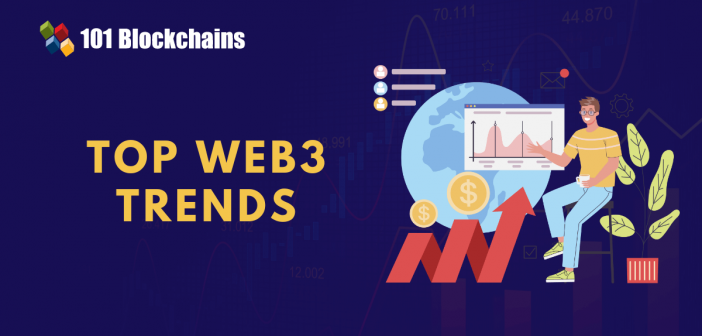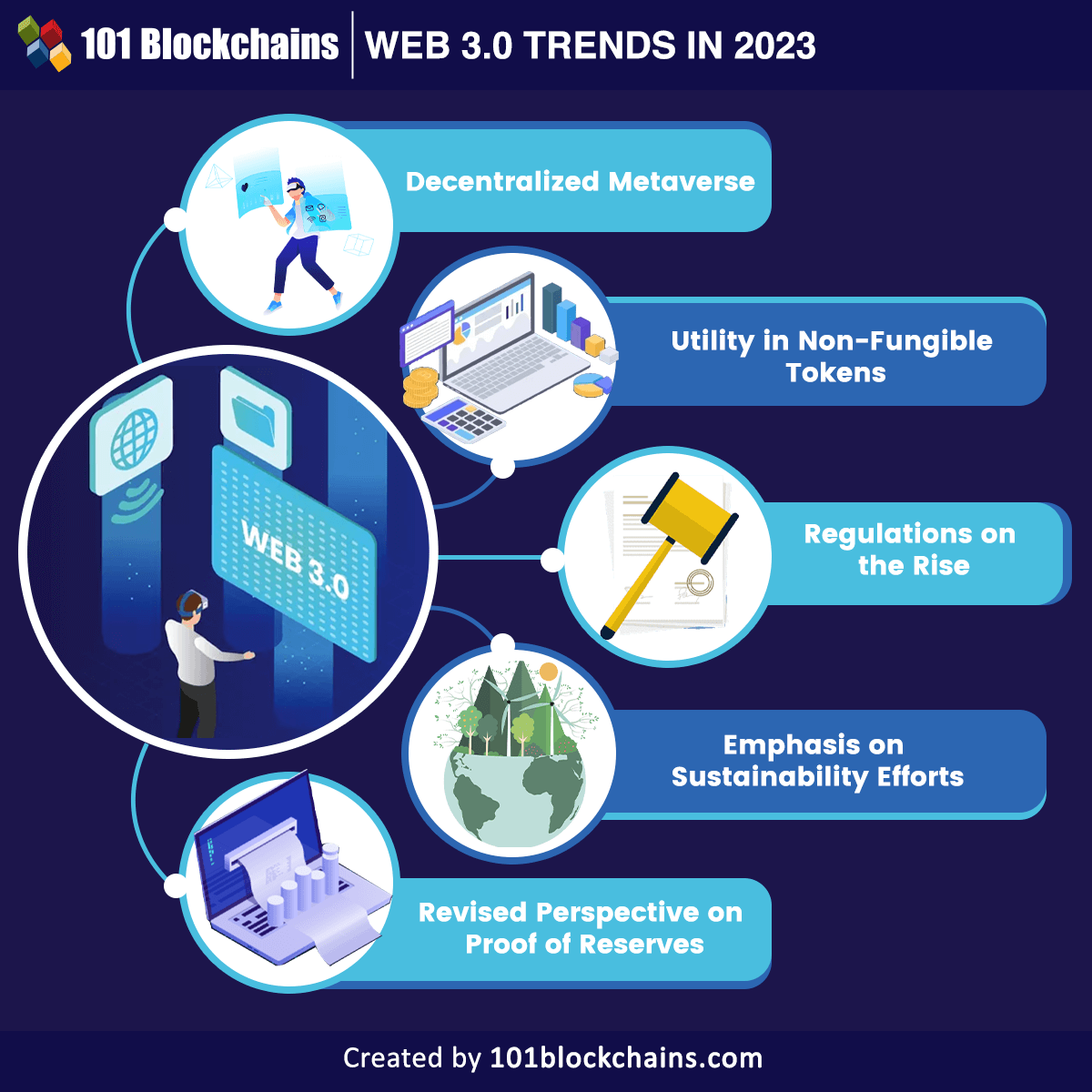Learn how blockchain truly works, master key definitions, and uncover what makes smart contracts so "smart." Dive into the fundamentals, gain valuable insights, and start your blockchain journey today!

- Web3
Georgia Weston
- on January 26, 2023
5 Web3 trends to watch in 2023
The effects of new technology trends influence the way users could access digital services and assets. Web3 has emerged as one such improvement for changing the conventional precedents of accessing internet applications and services. The emphasis on web3 trends has increased by huge margins in recent times. Why? Almost every business seeking new avenues for digital transformation wants to prepare for the future. On the other hand, web3 implies a type of future for the internet.
The internet is a vital aspect of the operations of almost every business today. Therefore, it is important to identify how changes in the web could affect users. Furthermore, the hype around web3 trends 2023 has been identified in the continuous growth of discussions around web3. The web3 space faced bad news for many crypto projects, such as the downfall of the FTX exchange and DeFi in 2022. However, web3 projects have been rolling out at a steady pace, irrespective of the downturns. The following discussion will help in identifying some of the top trends in the domain of web3 expected in 2023.
Why Should You Worry about Web 3.0 Trends?
The varying perceptions regarding the potential of web3 and its use cases have resulted in diverse assumptions about the web3 space. For starters, you must note that web3 does not refer to a single technology. On the contrary, it encompasses multiple trends which can describe a decentralized internet. The new decentralized web does not come under the control of big tech companies such as Google and Facebook. The interest in web3 trends 2023 has been growing strong, even after recent adversities encountered in blockchain and crypto markets. Why is everyone taking so much interest in web3?
The basic idea underlying web3 focuses on using technologies such as blockchain, NFTs, cryptocurrencies, and DAOs for creating online spaces. Users could have complete control over their assets and data in the decentralized online spaces. Without the intervention of centralized intermediaries, web3 offers the foundations for implementing digital democracies. Web3 puts the power back in the hands of users and creates new precedents for transforming the digital experiences of users with different products and services. Awareness of the latest web3 trends can help in identifying how web3 will develop as an industry in 2023. The trends in the industry could help in verifying the potential impact of web3 and the advancements it would entail.
Build your identity as a certified blockchain expert with 101 Blockchains’ Blockchain Certifications designed to provide enhanced career prospects.
Trends for Web 3.0 in 2023
As the world steps into new possibilities in 2023, concerns about top web3 trends are inevitable for blockchain and crypto enthusiasts. Most important of all, the general tech community has also been following developments in web3. Businesses want to learn about web3 to identify potential ways to use it in transforming their operations, processes and systems. Here are some of the most notable web 3.0 trends you should keep an eye out for in 2023.

Please include attribution to 101blockchains.com with this graphic. <a href='https://101blockchains.com/blockchain-infographics/'> <img src='https://101blockchains.com/wp-content/uploads/2023/01/Web-3.0-Trends-in-2023.png' alt='Web3 trends='0' /> </a>
1. Decentralized Metaverse
One of the most talked about highlights in the web3 domain refers to the metaverse. Popular tech giants, including Facebook and Microsoft, have started working on ideas for developing the next stage in the evolution of the internet. However, the concept of a metaverse in the future of web3 would differ significantly from the one envisioned by tech giants. Rather than creating centralized immersive platforms, the metaverse must develop as a shared universe that could accommodate the ideas of different proponents.
As of now, the most popular examples of decentralized metaverse are visible in The Sandbox and Decentraland. The underlying data operations of these decentralized metaverse platforms are stored on the Ethereum blockchain. Therefore, only the users with authentic permissions could modify, delete or add elements in the decentralized metaverse platforms. Without any centralized ownership of the server hosting metaverse data, users don’t have to worry about censorship. On the contrary, metaverse platforms like the one being developed by Facebook would always be at the mercy of the corporation. Decentralized virtual environments would serve as one of the top highlights in web3 blockchain trends for 2023. The industry can expect new pioneers to lead the way and establish foundations for developing more decentralized metaverse platforms.
While the concept of decentralized metaverse platforms would gain momentum in 2023, investment in metaverse projects would continue growing. A report by McKinsey in June 2022 revealed that around 66% of consumers expressed positive views on shifting everyday activities to the metaverse. Within the first five months of 2022, the investments in metaverse projects amounted to over $120 billion. In 2021, the investments in metaverse projects were only $57 billion. On top of it, web3 trends also point at the initiatives by brands and investors for reducing the gaps between physical and virtual worlds. Many renowned brands such as Starbucks, Nike, Adidas and Gucci have tapped into the metaverse with interesting components. As the drive for decentralized metaverse platforms gains momentum in 2023, the web3 community could expect some innovative breakthroughs in the domain of the metaverse in 2023.
Want to get an in-depth understanding of metaverse concepts? Enroll now in the Metaverse Fundamentals Course!
2. Utility in Non-Fungible Tokens
The next formidable trend in web3 would point at utility-based NFTs. Non-fungible tokens offer the benefit of uniqueness for an asset represented on the blockchain. NFTs serve as an ideal instrument for representing unique assets. However, most of the discussions around NFTs deal primarily with their use in digital artwork. NFT artwork emerged as a formidable trend in 2021 and created the foundations for new NFT collections such as Bored Ape Yacht Club and Rare Pepes. Interestingly, NFT artwork fetched thousands and even millions of dollars for creators and traders. However, the web3 trends for 2023 emphasize how non-fungible tokens can serve other use cases beyond the representation of ownership for digital artwork.
Web3 experts believe that the future of a decentralized web would offer better use cases for NFTs. Non-fungible tokens can foster the tokenization of data, intellectual property and assets in the digital as well as physical domains. NFTs could evolve as the keys for accessing and interacting with different digital products and services. In addition, the latest web3 trends also point to possibilities of using NFTs for the representation of smart contracts for accessing products and services. Furthermore, non-fungible tokens can also serve as keys for enabling access to the virtual spaces in the metaverse.
The emphasis on utility for NFTs would gain traction in 2023 and change the conventional perceptions about the transformative potential of non-fungible tokens. In addition, experts would most likely turn the limelight toward how NFTs fit in the broader yet undeveloped web3 ecosystem. On top of it, utility NFTs could also change existing notions about digital assets by enabling rewards and other exclusive privileges for NFT owners. For example, NFT projects like the Bored Ape Yacht Club have introduced utility for NFT holders in the form of exclusive access to meetups and parties.
Want to get an in-depth understanding of non-fungible tokens (NFTs)? Enroll now in the NFT Fundamentals Course.
3. Emphasis on Sustainability Efforts
The web3 industry has been subject to criticism on the grounds of its impact on sustainability. Blockchain technology, the foundation of web3, has been associated with concerns about high energy consumption, primarily drawn from fossil fuels. The top web3 trends in 2023 would also emphasize the best practices and strategies for driving sustainability in web3. The Bitcoin Energy Consumption Index by Cambridge University has revealed that the Bitcoin network only consumes around 84 terra-watt hours of electricity annually. It is alarming to note that the annual energy consumption of the Bitcoin network surpasses that of whole countries. For example, Argentina consumes around 130 terra-watt hours of electricity annually.
Apart from the concerns of disproportionate usage of natural resources, the environmental impact of web3 has also invited plausible concerns. For example, a single Bitcoin transaction has a massive carbon footprint with around 772 kilograms of carbon emissions. As a matter of fact, Elon Musk withdrew from any type of involvement with blockchain technology due to the higher energy consumption.
The future of web3 depends on reducing the amount of energy required for web3 applications, processes and systems. At the same time, it is also important to safeguard the usability of blockchain alongside the related web3 technologies. Interestingly, efforts for improving sustainability in web3 have started off with the Ethereum Merge. The Merge is the transition of Ethereum to a Proof of Stake consensus mechanism from the energy-intensive Proof of Work protocol. The Ethereum Merge happened in September 2022 and aimed to reduce the overall energy consumption of Ethereum by 98%. On the other hand, the World Economic Forum has recently launched the Crypto Sustainability Coalition to advocate use cases in ReFi or regenerative finance.
Curious to develop an in-depth understanding of web3 application architecture? Enroll Now in Web3 Application Development Course!
4. Regulations on the Rise
The outline of web3 blockchain trends would also draw attention to the increased possibilities for regulatory intervention in 2023. Web3 has emerged as a popular technology concept with a significant transformative impact on different industries. Therefore, governments are more likely to step into the web3 domain for monitoring and regulation web3 impact on society, the environment and economies.
As a matter of fact, certain states in the US, such as Wyoming, have introduced their own regulations for indicating their affiliation towards web3. The regulations imply that businesses dealing with web3 can receive special tax privileges and favorable treatment for their compliance with web3 regulations. In addition, Colorado also introduced a milestone legislation by officially accepting cryptocurrency for payments of state fees and taxes.
Interestingly, the impact of such web3 trends in 2023 would extend to countries other than the United States. Dubai is one of the popular examples of countries opening up to a regulated approach for web3. Many other countries, such as India and China, are also likely to move further in 2023 with significant changes in regulations for web3.
5. Revised Perspective on Proof of Reserves
The year 2022 spelled a gloomy phase for crypto and blockchain in general, particularly with the collapse of FTX, one of the biggest centralized crypto exchanges. However, the dynamic and adaptive nature of blockchain and the web3 landscape led to the immediate resolution of the problem with Proof of Reserves. The future of web3 would rely on how users trust crypto exchanges with their assets. Proof of Reserves offered an effective audit mechanism for verifying that exchanges have the reserves to back up user deposits and support liquidity. However, some exchanges have avoided their liabilities in Proof of Reserves and pointed out only their crypto holdings.
Therefore, another prominent entry among the latest web3 trends would point at possibilities for introducing Proof of Liabilities. It can develop alongside the Proof of Reserves audit concept and could boost trust in centralized exchanges. As of now, many ideas for developing Proof of Reserves and Proof of Liabilities have been put to the test. For example, the use of Merkle trees for verifying reserves backing up assets. Similarly, the use of decentralized oracles for verifying on-chain and off-chain proof of reserves can also improve trust in centralized exchanges.
Build your fluency in advanced technologies and develop decentralized solutions for the emerging web3 ecosystem as a web3 expert through Web3 Expert Career Path
Conclusion
The emerging trends in web 3.0 showcase how it is still a nascent concept developing gradually with the introduction of new technologies. At the same time, the top web3 trends also reflect the critical pain points for web3 right now. Starting from the decentralization of metaverse platforms to adding utility in NFTs or introducing regulations, 2023 has a lot in store for the web3 landscape. In addition, concerns regarding the sustainability and trust of users in centralized crypto exchanges would also hog the limelight in the domain of web3. Develop your skills and knowledge in web3 to prepare for the technology of the future.
*Disclaimer: The article should not be taken as, and is not intended to provide any investment advice. Claims made in this article do not constitute investment advice and should not be taken as such. 101 Blockchains shall not be responsible for any loss sustained by any person who relies on this article. Do your own research!







